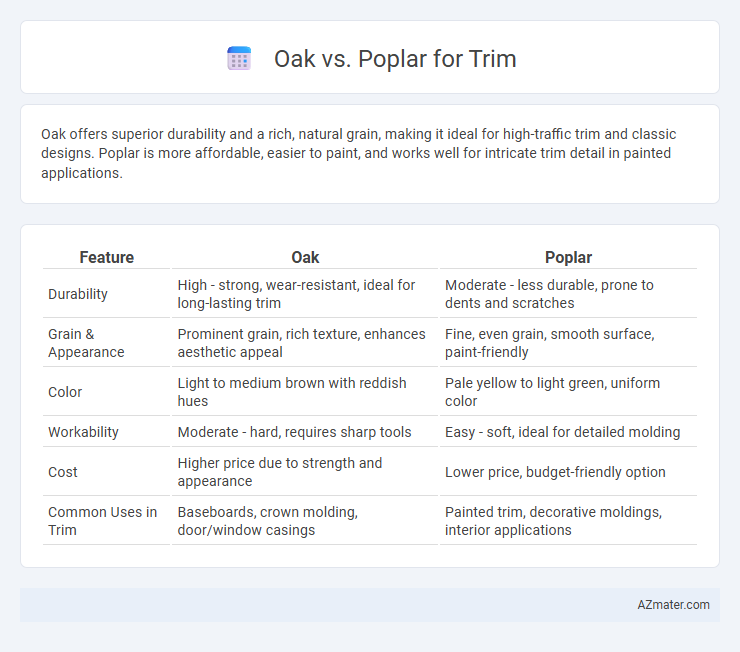Oak offers superior durability and a rich, natural grain, making it ideal for high-traffic trim and classic designs. Poplar is more affordable, easier to paint, and works well for intricate trim detail in painted applications.
Table of Comparison
| Feature | Oak | Poplar |
|---|---|---|
| Durability | High - strong, wear-resistant, ideal for long-lasting trim | Moderate - less durable, prone to dents and scratches |
| Grain & Appearance | Prominent grain, rich texture, enhances aesthetic appeal | Fine, even grain, smooth surface, paint-friendly |
| Color | Light to medium brown with reddish hues | Pale yellow to light green, uniform color |
| Workability | Moderate - hard, requires sharp tools | Easy - soft, ideal for detailed molding |
| Cost | Higher price due to strength and appearance | Lower price, budget-friendly option |
| Common Uses in Trim | Baseboards, crown molding, door/window casings | Painted trim, decorative moldings, interior applications |
Introduction to Oak and Poplar for Trim
Oak offers a dense grain and exceptional durability, making it a preferred choice for trim that requires strength and a classic appearance. Poplar features a softer texture with a fine, even grain, providing ease of painting and a cost-effective option for interior trim projects. Both woods are widely used in cabinetry and molding, but Oak's hardness makes it more resistant to wear, while Poplar's workability suits intricate designs and detailed trim work.
Appearance and Grain Patterns
Oak trim features a prominent, open grain with bold, intricate patterns that add texture and character to any space, making it ideal for traditional or rustic interiors. Poplar trim has a smoother, more uniform grain with subtle patterns, offering a clean and consistent appearance suitable for modern or minimalist designs. The contrast between oak's rich, varied grain and poplar's fine, even texture helps determine their best use in trim applications based on desired aesthetic impact.
Durability and Hardness Comparison
Oak trim offers superior durability and hardness, with a Janka hardness rating of approximately 1290 for red oak, making it highly resistant to dents and wear. Poplar trim, with a Janka rating around 540, is softer and more susceptible to damage but easier to machine and paint. For long-lasting, impact-resistant trim, oak remains the preferred choice due to its robust strength and resilience.
Cost Differences: Oak vs Poplar
Oak trim typically costs between $4 and $7 per linear foot due to its density and durability, making it a premium choice for high-traffic areas. Poplar, costing around $2 to $4 per linear foot, offers a budget-friendly alternative with a softer wood that is easier to paint and work with. The cost differences reflect oak's natural hardness and grain quality compared to poplar's affordability and versatility in trim applications.
Workability and Ease of Installation
Oak trim offers superior durability but is denser and harder to cut or shape, requiring sharp tools and more effort during installation. Poplar trim is softer and lighter, making it easier to saw, sand, and paint, which significantly reduces labor time and effort. The choice between oak and poplar for trim hinges on balancing the harder workability of oak against the smoother installation process of poplar.
Paint and Stain Suitability
Oak offers excellent stain absorption due to its open grain, making it ideal for rich, natural finishes, while its dense texture holds paint well, providing a smooth, durable surface for trim. Poplar, known for its tight, uniform grain, is highly suitable for painting, delivering a smooth base that minimizes blotching and requires fewer paint coats. Although poplar can be stained, it tends to absorb unevenly, often necessitating a grain filler for a consistent finish, unlike oak's naturally stain-friendly grain.
Maintenance and Longevity
Oak trim offers superior durability and resistance to wear, requiring less frequent maintenance compared to poplar. Poplar, while easier to paint and more affordable, is softer and more prone to dents and scratches, leading to higher upkeep over time. Choosing oak ensures greater longevity and minimal refinishing, making it ideal for high-traffic areas.
Environmental Considerations
Oak trim offers durability and a longer lifespan, reducing the need for frequent replacement and minimizing resource consumption over time. Poplar is a faster-growing wood species, making it a more sustainable choice due to quicker regeneration rates and lower environmental impact from harvesting. Both options benefit from sourcing FSC-certified lumber to ensure responsible forest management and reduced ecological footprint.
Best Applications for Oak and Poplar Trim
Oak trim offers superior durability and a prominent grain pattern, making it ideal for high-traffic areas, traditional interiors, and spaces requiring a robust, classic aesthetic. Poplar trim features a smoother texture and is easier to paint, which suits modern homes, budget-conscious projects, and applications needing crisp, clean lines with versatile color finishes. Both woods provide unique advantages: oak excels in strength and natural beauty, while poplar supports customization and cost-effectiveness in trim work.
Choosing the Right Wood for Your Project
Oak offers exceptional durability and a prominent grain pattern, making it ideal for high-traffic trim areas requiring long-lasting strength and a classic aesthetic. Poplar, known for its smooth texture and affordability, excels in painted trim projects due to its uniform surface and easy workability. Selecting between oak and poplar depends on your desired finish, budget, and the trim's exposure to wear and tear.

Infographic: Oak vs Poplar for Trim
 azmater.com
azmater.com